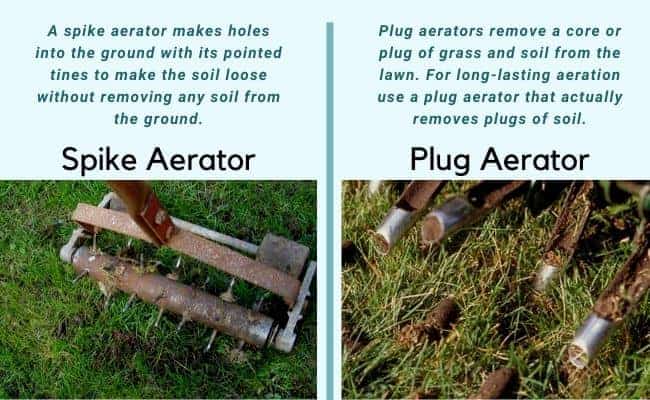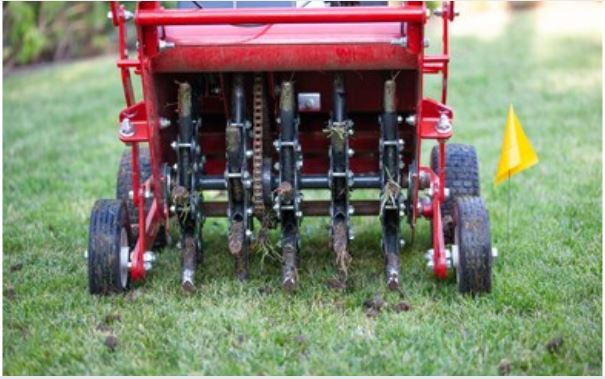Lawn aeration makes sure your grass gets adequate water and nutrients as well as loosens the soil for proper development of roots. But when it comes to core aeration, should you use a spike aerator or a plug aerator?
A spike aerator has sharp tines that penetrate the ground to make holes and aerate your lawn while a plug aerator has hollow tines that penetrate the core and pull out plugs of soil. Spike aeration is suitable for small lawns with mild compaction while plug aeration is good for fixing severe soil compaction and on large areas.
Spike vs Plug Aerator – Differences

Here’s a quick table showing the differences between spike and aerators.
Spike Aerator | Plug Aerator |
Spike aerators have sharp spikes that penetrate into the ground. | Plug aerators have hollow tines that remove plugs of thatch when pushed into the ground. |
Provides short term soil decompaction since no soil is removed. | Provides long-term decompaction because plugs of soil are removed from the core to create air spaces. |
Mostly manual spike aerators are available and suitable for getting rid of soil compaction on small yards. | Mostly mechanical plug aerators are available and suitable for small, medium, and large areas of yard soil decompaction. |
As you can see from the differences above, you may want to use a spike aerator if you have a small yard. It is also a suitable choice when you want to get rid of minor thatch that’s causing compaction. Read this guide if you aren’t sure what thatch is!
Plug aerators are mostly mechanical, unlike spike aerators which are mostly manual (except for the ones you hook on your lawnmower).
In this sense, using a plug aerator is one of the best ways to ease soil compaction because the plugs are removed from the core to make the soil loose. Poking holes is less effective and can actually cause additional compaction in the areas around the holes.
Spike Aeration
A spike aerator makes holes in the ground to make the soil loose. Unlike plug aerators, spike aerators do not remove any soil from the ground. They only poke holes in the ground to get rid of compaction.
Spike aeration is great, but it gets rid of soil compaction on a short-term basis. Instead of removing soil plugs from the core of your lawn, the aerator’s sharp tines push soil down and to the sides.
Some mechanical spike aerators are curved and can provide very deep penetration – sometimes up to 9 inches deep without causing a mess of plugs on your grass.
Does spike aeration work?

Spike aeration works but provides short-term results because when you push the aerator into the soil, it pushes the soil down and to the sides instead of removing the thick thatch that is causing compaction. With time, the soil will readjust and close the small holes you made in the ground.
The little holes do not reduce core compaction but they actually increase compaction deep in the ground.
Spiked lawn aerator shoes are way too slow at the job. You can imagine spike aerating a 1000-square-foot lawn using aeration shoes. It will take a lot of energy and time to complete the task.
- Adjustable Size: The 11.5* 5 inch Aerator Shoes fit for women's shoe size 6-10, men's shoe size 6-9, with 3 adjustable Velcro straps wraped around your heel and attach with hook-and-loop fasteners, no slipping and loosing.
- Never Broken of Shoes Base: Design with using 2 Base of ALUMINUM ALLOY and PLASTIC SOLES to ensure sturdy, durable and comfortable, instead of other's only with plastic or metal soles.
- Never Bend of Spikes: Heavy Duty Spikes add oxygen, water and nutrients to soil easily. The yeld strength reaches 675Mpa which is enough sturdy, suitable for any hard soil, rocks, or slopes.
Affiliate links and images pulled from the Amazon Product Advertising API on: 2024-04-26
How often should I spike aerate my lawn?
It is best to spike-aerate your lawn 2-3 times every season or once every couple of months because the results do not last long. However, if you used a plug aerator even once in the last two seasons, you may need to spike-aerate just once a season to get rid of minor compaction problems.
Always test the thickness of thatch in your lawn two times each season to determine if it is too thick and causing compaction. If it is too thick, you may need to rent a mechanical aerator and dethatcher to help you get rid of the problem. Here’s how to determine if that layer in your lawn is too thick.
Types of Spike Aerators
Lawns that are not badly compacted can be fixed with a spike aerator. Depending on the size of your lawn, you can choose from a variety of them, including the following:
Spiked shoes
Spiked lawn aeration shoes are made of narrow, sharp spikes protruding from the sole. You can use them to aerate a fairly small yard just by walking all over it.
The spikes are usually thin enough to reduce the resistance you’ll get when pushing them into the ground. You may need to leave your oscillating sprinkler watering your lawn for some time to make it easy when you start aerating with these shoes.
These are the ones I have been using this season
- PROFESSIONAL-GRADE AERATION - Wear our Abco sport yard aerator spike shoes and walk around to cover the entire length of your garden for a way greener, healthier, and more beautiful lawn and grass. Even better- wear these aerating shoes for lawn while mowing your lawn so that you accomplish two important tasks simultaneously!
- INEXPENSIVE & FUN ALTERNATIVE - These lawn aerator shoes offer a superior alternative over professional gardening services which might cost you fortunes on lawn care and maintenance. However, these lawn aerator shoes for grass are a one-time investment that’s going to help you with several hundred cycles of yard aeration and, if maintained well, even for a lifetime.
- SUPERIOR BUILD - Our grass aerator for lawn is made up of a sturdy plastic base with good heel support, 13 heavy-duty metal 48-mm spikes on each sandal, and 3 adjustable straps with strong buckles, designed to be highly anti-corrosive and durable. The aeration shoes for lawn stay firmly on your feet, and the sharp nails make it easy to dig the soil and an effective core aerator.
Affiliate links and images pulled from the Amazon Product Advertising API on: 2024-04-26
Hand and foot manual aerators
These are the type you hold with your hand to place them upright on the lawn, and then step on to push the tines down into the soil to aerate.
While I recommend hand-and-foot manual spike aerators, I find them to be time-consuming and a little energy-intensive to use. You’ll be exhausted if you have a large area to aerate.
On a brighter note, manual aerators are pretty much cheap and easy to use, so you can have one for lighter aeration lawn maintenance.
Mower wheel spikes
You’ll not find these ones easily in the market, but they do exist. They are accessories added to the wheel of a self-propelled lawn mower so you can aerate the core of your lawn while mowing.
The downside of these spikes is that they are small and may not really make deep holes. For a lawn that is badly compacted, wheel tines may not be able to fix compaction issues properly.
Push spike aerator
Push aerators are circular just like lawn rollers except that they have spikes all over them. As you push them, the spikes make holes in the lawn, uncompacting the core.
Since you’re the one pushing the aerator, you really want to prepare the ground by watering it deep enough to make it soft, otherwise, the task of pushing the aerator to loosen up the soil will be tough.
This is my favorite one that I have been using mostly these days.
- 【Bring New Life to Lawn】With the length of 1.2-inch tine spikes, this rolling lawn aerator will be able to roll deeper into the ground. As a result, the soil will get loose, making it easy for water, oxygen, and nutrients to diffuse into the soil pores. As time passes by, the grass and plants will grow more rapidly and splendidly.
- 【Equipped with A Protective Shield】The unique feature of this aerator lawn tool is the use of a protective shield, which prevents the splash of the mud. Not only will your clothes and shoes remain clean and dry, but most importantly, your feet will stay safe and unharmed.
- 【Labor-saving & Lightweight Tool】The length of the handle is about 41 inches, which allows you to operate the push aerator without bending down. Also, the width of the spike is 18 inches to increase the range of soil turning. Thanks to its light-weight design and compact size, it is easy to push around even on rough terrain.
Affiliate links and images pulled from the Amazon Product Advertising API on: 2024-04-26
Plug Aeration
A plug aerator is much different from a spike one because it removes plugs of thatch from the ground. This makes it a very effective tool for relieving soil compaction for the long-term.
How does a plug aerator work?
Plug aerators have hollow tines that remove about an inch of thatch from the core when pushed into the ground, making it well-aerated. They are much more effective at getting rid of soil compaction even in yards with clay soil, and the effects are long-term compared to those of spike aeration.

Some of the best plug aerators are mechanical. Here’s how they relieve core compaction:
- Plug aeration machines have hollow tines that rotate while rolling on the lawn.
- The tines remove cores of soil that are about an inch long and about a dime’s diameter.
- Plug aerators are much more successful at loosening up compacted soil and getting rid of the compaction.
Tow Behind Plug Aerators
Tow behind aerators attach to your lawn tractor and do the aerating work as you drive the tractor. With these, you want to go at the slowest speed you can to be sure you are getting good penetration and not tearing through the lawn.
- 24 heat-treated plugging spoons
- Durable, all steel design
- Easy transport with 10" semi-pneumatic rubber tread tires
Affiliate links and images pulled from the Amazon Product Advertising API on: 2024-04-26
How deep should core aeration plugs be?
For the best results, plug aerator tines should make holes 1-6 inches deep into the ground and remove plugs that are about 0.5-0.75 inches wide. Mechanical core aerators are great for long-term aeration because they remove plugs up to 6 inches apart, making your lawn soil loosen up significantly.
The problem with most plug aerators is that they are commercial machines. However, I bought one for my own home use, and it does a great job.
Should I pick up the plugs after aerating?
You don’t need to pick up the plugs after core aeration because they’re usually a thick mass of decomposing thatch with a lot of nutrients. You can leave them on the lawn to break down and release nutrients into the soil and feed the grass.
However, if you don’t like their appearance, you can rake and add them to your compost. Once fully decomposed, you can use it for topdressing areas where you need to overseed the lawn, or even for growing new sod.
Can you aerate a lawn too much?
Since plug aerators are so effective at uncompacting soil in the yard, I recommend you use them just once a season, or even once every few seasons unless your soil issues are fixed.
Lawns established in clay soil are the most problematic when it comes to compaction, so, core-aeration about two times a season will ensure you maintain a healthy lawn. In clay soil, use a plug aerator instead of a spike aerator. Wondering how often you should aerate your lawn?
If your grass is thick and full such as Bermuda grass, you may need to aerate a little more often because this type of grass can quickly form a layer of thick thatch really fast especially if you don’t dethatch quite often.
References
- Virginia Cooperative Extension: Aerating Your Lawn
You may also like…
Does Liquid Lawn Aeration Work?
Hi, Alex Kuritz here. Growing up I remember that my family had one of the best lawns in the neighborhood. Richly green and lush. I did a lot as I grew up in terms of caring and tending for not only my family’s lawn but also my neighbors. I can say I have years of experience, and I am here to share it with you.







Your statement “In clay soil, use a spike aerator instead of a spike aerator.” Which is it? Plug aerator or plug for clay?
Ha, I do that kind of crazy stuff all the time. But, he did say “Lawns established in clay soil are the most problematic when it comes to compaction, so, core-aeration about two times a season will ensure you maintain a healthy lawn. In clay soil, use a plug aerator instead of a spike aerator.”
Hi James, thank you for pointing that out. It was an editing error that I’ve corrected and highlighted the paragraph.
Since clay soil gets compacted really fast and poses drainage problems in the lawn, a plug aerator is the best option you want to go with here.